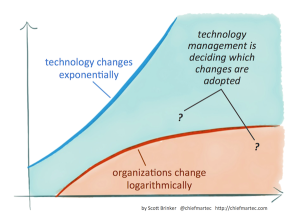In the competition for the best visualization of the kaleidescopic marketing technology space — other entries include my marketing technology landscape from last year and the marketing technology LUMAscape from last month — I’d say Gartner has just jumped into the lead with their new digital marketing transit map.
Their high-level map is visualized around types of products and services — represented as stations on the map — rather than the individual vendors themselves. However, Gartner has cataloged more than 1,800 vendors to create this map.
It’s pretty breathtaking in scope.
There are 12 tracks, such as Marketing Management, Creative, and Analytics, which share common objectives and information. And they go through 7 neighborhoods, such as Marketing Ops, Web Ops, and Ad Ops, which are typically different practice areas within an organization. And there are offline connections to sales and service, general advertising, business intelligence, IT, and the CMO’s office.
All lines converge in a “digital marketing hub” — the central DM HUB station — in the middle of the map.
Important note: this is a human-powered transit system
Looking at this map, you cannot help but be awestruck by the breadth and depth of digital marketing. I mean, holy cats, I work in this space for a living and write this blog as my hobby — I know, I don’t get out much — and I don’t even know some of these stations. Many of them I have only a passing familiarity with.
In spite of huge deals such as Salesforce/ExactTarget and Oracle/Eloqua, it’s clear from this map — remember 1,800 different vendors were cataloged to assemble it — that marketing technology is diversifying more than it is consolidating. The Emerging Tech track alone is a source of incredible disruptive innovation ahead.
So I can fully empathize with — and have enormous respect for — marketing leaders who are struggling to sort out a cohesive strategy in this landscape. Nobody can master all of these. The real lever you have is to decide which stations you’re going to prioritize. From my post last week, this is Martec’s Law: technology changes exponentially, but organizations change logarithmically.
The art of marketing management is the strategy you use to choose which changes to focus on, and which ones you intentionally let slide, at least for the moment. And successfully implementing that strategy is far more about people and processes than it is the technologies themselves.
Which leads me to my main takeaway from this map: the “trains” are people.
There is no technology that delivers the seamless interconnectivity between these stations as it’s portrayed here. You can’t just hop the Ad Tech red line to get from native ads to attribution, transfer over to the Analytics orange line, and arrive at predictive campaign analytics in an easy 20-minute ride. The connections between these disparate stations are made via human collaboration — people and processes. It’s messy and evolutionary and varies tremendously from one organization to another.
There may be some technical plumbing, but most of it is highly informal and custom-built within each organization. (Marketing technologists are often the metaphorical plumbers.)
Most of all, there is no “DM HUB” technology today that seamlessly merges all these tracks together into the marketing equivalent of Grand Central Station. Sure, there are companies and service providers that are bringing a subset of these pieces together. But most of their strategies to date have been implemented as marketing suites rather than marketing platforms — which is like trying to hold back the ocean with a sandcastle (albeit a very elaborate one).
The digital marketing hub is an organizational entity, not a technological one.
But even in that light, this map from Gartner is extremely helpful because it visually raises the question: how are you bringing these neighborhoods together in your company? What does your digital marketing hub look like today, and what are your plans for expanding it to handle the massive influx of population ahead?






Thanks for sharing, Scott. It’s striking to me that while many customer research and Voice of Customer (VOC) programs have become heavily reliant on social listening and online communities…that a connection to an “insights” neighborhood or players is missing here. Useful though!
LCI